Summer is prime snapping turtle time. Although many are put off by the snappers prehistoric looks, downright spiteful attitude, and reputation for eating all the nasties of the aquatic world; those in the know about snapping turtles know that the meat is some of the most delicious and lean wild meat out there.
Be forewarned, there’s nothing zippity do dah easy about snapping turtles, not the catching, not the cleaning or the cooking. Perhaps that’s part of what makes them so tasty. It’s a bit of an accomplishment to put a turtle on the dinner table.
First things first- check the regulations regarding the hunting/taking of snapping turtles before you ever venture out in search of these ill-tempered monsters. Regulations vary widely from state to state and also within areas of a single state. For instance, here in Illinois, it is legal to bowfish for turtles during turtle season (June 15 through August 31) except in specific southern counties where alligator snappers have been sighted and confirmed.
Alligator snapping turtles are a whole different turtle and protected in many states. Make sure you know the difference between an alligator snapping turtle and common snapping turtle.
Common snapping turtles (Chelydra serpentina serpentina) are native to the Midwest. The alligator snapping turtle, Macroclemys temminckii, which lives mostly in the southeastern U.S. and can weigh over 120 pounds, is a close relative. Common snapping turtles average 10 to 12 inches in length (upper shell length) and have an average weight of 15 to 25 pounds. If there is mud, water, and reasonable supply of food, its likely snapping turtles may live there. They inhabit all sorts of aquatic homes: large creeks, rivers, river sloughs, swamps, marshes, lakes, farm ponds and sewage lagoons.
As for their food supply, snapping turtles will eat just darn near anything that crosses their path (dead or alive) including fish, frogs, drowned animals, goslings, ducklings, small birds, crayfish and aquatic plants.
Catching Snapping Turtles
Catching snapping turtles is the easiest part of the whole process. Often anglers fishing for catfish catch snappers while using jugs, trotlines, tightlines or limb lines baited with cut bait, live bait or chicken livers. In general if the bait appeals to a catfish it’s also going to appeal to a snapping turtle. Thankfully turtles caught with jug lines usually move near the shore, making them easier to retrieve and handle. Other turtle catching methods include “handfishing” and “rodding” along rivers and streams or, during the winter months, spotting and catching them through the ice. The ice method only works well if you have both clear ice and relatively shallow water; look for turtles half buried in the mud, chip through the ice and grab them by the tail. As you might guess turtles are slow at this time of the year, making this a little less difficult than hand fishing for them in the warmer months when they can turn and snap a finger off in the blink of an eye. In some areas it’s also legal to use a spear, gig, or to bowfish for them.
The easiest way to capture a snapper is to catch them crossing the road when they are traveling from one soggy swamp spot to another.
Once you have a snapper in your possession, and prior to killing the snapper, it’s best to put it in a clean out tank for about a week rather than cleaning right away. Keep it in a tub of clean water for a period of time. Small livestock water tanks and clean plastic barrels work great for this. Change the water every few days until it remains relatively clear.
Cleaning a Snapping Turtle
Cleaning a snapping turtle can be a bit tedious; it’s not difficult, just somewhat time consuming.
- Cut the turtle’s head off and hang the turtle upside down for a short period to bleed.
- Nail or otherwise fasten the upside down turtle’s tail to a stump so that most of the shell hangs off the stump but is parallel to the stump surface. I prefer using a wide flat board with a nail sticking up through it and impaling the turtle on the nail with its underside facing up. Makes for sort of a turtle lazy Susan and I can spin the turn to get to all the parts easily.
- Cut and remove the plastron or bottom shell. Using a fillet knife loosen the skin from all the way around the shell, then slide the fillet knife under the plastron to remove it whole. After removing the plastron, carefully remove the skin from the legs, neck and tail.
- Cut through the pelvic bone (being careful not to puncture the bowel, bladder or gall bladder) and open it up enough to reach in scoop out the intestines, lungs etc. (save these organs for catfish bait if you are so inclined) It’s vital that you do not puncture he liver or gall bladder. This will give the meat a very bitter taste if either winds up spilling bile on the meat.
- Remove all skin from legs and neck.
- Next cut away each leg and the neck from the carapace or shell. Turtle fat is yellow and should be removed from the meat. Even the tiniest speck of turtle fat will wreck the taste.

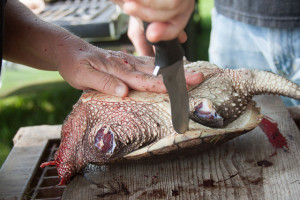
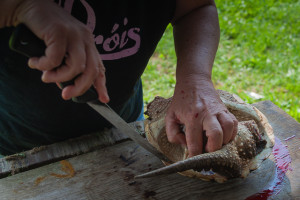
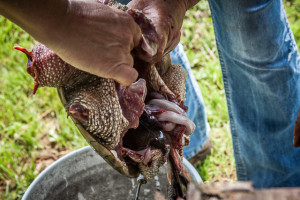


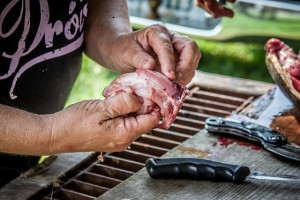
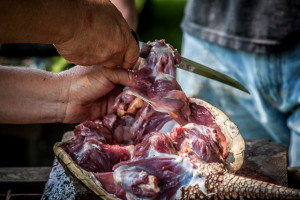

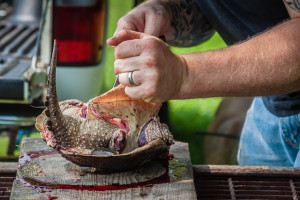
Snapping turtles can be prepared in a variety of ways. It’s important to note that like many very lean wild meats, a low and slow cooking method can produce the best results.
Turtle meat should be parboiled prior to using in any recipe. My personal preference is to place a layer of onions and peppers in the bottom of a crock pot, layer the turtle meat on top, then add just enough water or whatever stock (chicken or vegetable) I have handy to cover. Cook on the low setting 8 -12 hours.
Now the turtle meat is ready for most any recipe you have. It can be stir fired, barbequed, made in to soup – you name it. Turtle meat makes any recipe delicious.
Many people enjoy turtle meat fried. This is best done by either parboiling it first until fork tender, then breading and frying, or the more popular method is to fry and then wrap the fried pieces in foil and roast in a 350 degree oven for about two hours.
I suggest you try this soup recipe; it’s always a crowd pleaser at my house!
Mama G’s Turtle Soup
- (2-1/2 sticks) unsalted butter
- 3/4 cup all-purpose flour
- 1- 2 pounds parboiled turtle meat, cut into 1/2-inch cubes
- 1 cup minced celery (4 stalks)
- 2 medium onions, minced (2 medium)
- 1 cup sweet corn kernels (fresh, frozen or canned)
- 1 cup green beans (fresh, frozen or canned)
- 1-1/2 teaspoons garlic, minced
- 2 tablespoons High Mountain Cajun style seasoning
- 1 tablespoon Old Bay seasoning
- 1-1/2 cups tomato purée
- ½ can or bottle of beer
- 1 quart water or stock of your choice
- Salt and freshly ground black pepper to taste, as needed
Melt 2 sticks butter in a heavy saucepan. Add the flour and cook, stirring frequently, over medium heat until the roux is light brown. Set aside.
In a 5-quart saucepan, melt the remaining butter and add turtle meat. Cook over high heat until the meat is brown. Add celery, onions, garlic and seasonings, and cook until the vegetables are transparent.
Add tomato purée, beer, corn and green beans lower heat and simmer for 10 minutes. Add the stock and simmer for 30 minutes. Add the roux and cook over low heat, stirring, until the soup is smooth and thickened. Remove from heat and serve.
Alternately you can skip the roux making and transfer browned vegetables and all other ingredients to a crock pot and cook on low 6-8 hours.
*Special Thanks to Jaclyn Sisk for photographing the cleaning process while I handled knives instead of a camera for a change*












